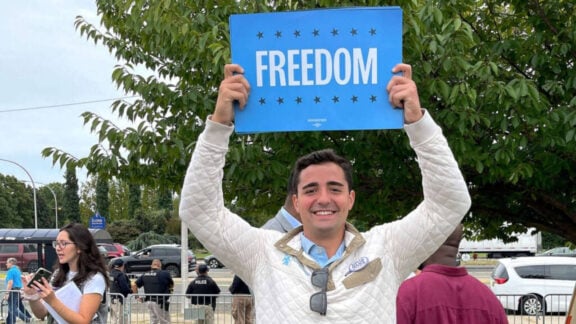“Every 30 minutes one Australian loses their life to heart disease.”
This sobering message, was used by the Heart Foundation to launch this year’s campaign for Heart Week (1-7 May), to raise awareness and emphasise the importance of knowing your risk. 30 minutes is also all it takes, to conduct a Heart Health Check, which could ultimately save your life.
Associate Professor Arthur Nasis, Head of Acute Cardiac Services at MonashHeart, and Director at Victoria Heart told Neos Kosmos that more than 10,000 Australians died of ischaemic heart disease in the first eight months of 2022, a rate that is about 17 per cent higher than would be expected in a typical year!
Though it is not clear why the rate has increased so much, the Greek Australian cardiologist believes that “the two main contributing factors are the strain of the pandemic on our healthcare system and the effects of coronavirus itself on the heart.”
He says that multiple local and international studies have implicated coronavirus in an increased risk of many cardiovascular problems, which on top of the already heavy burden of many pre-existing cardiac risk factors has undoubtedly compounded what was already a major problem.
“A study published in the prestigious ‘Nature Medicine’ journal last year in military veterans in the St Louis Health Care System who had recovered from COVID infection and were found to have substantially higher rates of over 20 cardiovascular conditions including heart attacks, abnormal heart rhythms, heart muscle inflammation and stroke compared to those who hadn’t had COVID.
An Australian study published earlier this year in the Medical Journal of Australia also found that the risk of being hospitalised from myocarditis (inflammation of the heart muscle), pericarditis (inflammation of the membrane lining the heart), heart attack and stroke were significantly more common after COVID infection.”
This elevated risk, he adds, also applies to patients who were not hospitalised for COVID infection, in other words people who seemed to have completely recovered from a mild infection.
“With millions of people having been infected with COVID, I wonder whether the pandemic will be followed by a cardiovascular aftershock”
It is still not understood who is most at risk of these heart-related problems after COVID or how long the risk persists. “Only time will tell if the risk passes, or if infection changes the lifelong trajectory for risk of heart attack, stroke and other cardiac events. We just don’t know yet.”
Ischaemic heart disease is the leading single cause of deaths in Australia
The saddest part about these deaths, is that more often than not, they can be prevented.
The two most common misconceptions, according to Dr Nasis is that “heart disease is a man’s disease” and that “heart disease is only caused by a poor lifestyle, so fit and active people are protected”.
“Heart disease kills the same proportion of women as it does men – that’s over a quarter of all men and women. In fact, coronary artery heart disease kills more than twice as many women than breast cancer. This misconception can mean that women are less aware of the risk factors, or the symptoms of a heart attack, and are slower to call 000 when they have a heart attack which could dramatically reduce their chance of survival.”
Also, he adds, many people with heart disease are very fit, but despite this develop heart disease based on genetic factors, and even other factors which still remain unclear, and are a strong focus for ongoing research.
One valuable lesson we can learn from these tragic deaths is that early intervention is crucial.
“The process that leads to a heart attack (which is the most common cause of heart disease) usually starts many years earlier and is referred to as coronary heart disease; the narrowing of one or more heart arteries due to a build-up of fat, cholesterol and other inflammatory materials, known as coronary plaque. With time, the narrowed artery causes reduced blood flow to the heart muscle, which can lead to chest pain.”
Dr Nasis explains the three simple steps to help keep Australian hearts healthy
“Firstly, measure your blood pressure. High blood pressure is a leading risk factor for heart disease. The only way to find out if your blood pressure is high is to have it checked regularly, even if you feel completely well.
Secondly, calculate your heart age. This simple calculator can be found easily online (visit campaign.heartfoundation.org.au/heart-week) and uses well-known risk factors for heart disease such as age, sex, blood pressure, cholesterol, weight and smoking status to estimate your risk compared to an established healthy range. If your heart age is higher than your actual age, you may be at higher risk of having a heart attack.
Last but not least, book a Heart Health Check with your GP. This is a 20-minute check-up to assess your risk of having a heart attack in the next five years. As part of the check, your doctor will ask you about your lifestyle, medical and family health history as well as check your blood pressure, cholesterol and blood sugar levels. This information will provide the information needed to estimate your risk of a heart attack and steps to be implemented to lower your risk.”
The head of Acute Cardiac Services at MonashHeart adds that the combination of tests you need to do to get diagnosed, are mostly simple, non-invasive and quick. “These include CT calcium scoring, CT coronary angiography, stress testing”, though sometimes, invasive coronary angiography may be recommended.
“Once the diagnosis has been made, management involves lifestyle changes and medications. This combination is sufficient in most people. In more advanced cases, unblocking any severe heart artery blockages with a balloon and stent may be required. Rarely, if there are multiple arteries blocked, open heart surgery with coronary artery bypass grafting may even be needed.”
Dr Arthur Nasis is a strong advocate of a heart-healthy lifestyle and believes in the benefits of a Pesco-Mediterranean diet.
“When it comes to a lifestyle and a diet beneficial to the heart and our wellbeing we only need to look for inspiration to the first generation of Greek Australians who have the second highest longevity in the world, after the Japanese, according to researchers. Their diet is very high in fish, in vegetables, and much less red meat, fats, and dairy products that can increase our cholesterol. Many studies around the world have shown that a Mediterranean diet, the use of olive oil, significantly reduces risk of heart disease.”
For people to succeed in sticking to a healthy lifestyle, and to help them kick potentially deadly habits, Dr Nasis states that the first step is education.
“When you understand why and how your lifestyle is impacting your heart health, you are empowered and in a better position to make positive change.”
“Talk to your doctor, talk to people who were in a similar position to you who have made positive changes, and enlist the support of professional organisations. The National Heart Foundation has a range of print and digital resources and can provide email and text support to those that need it. Among other things, the material will help you understand more about heart disease and risk factors, including how to reduce your risk of heart problems. More specifically, they provide access to a range of heart healthy recipes, resources like personal walking plans to help you in your physical activity journey, quit smoking action plans and alcohol action plans to help you kick potentially deadly habits.”
The symptoms and what to do in an Emergency
“The most common warning sign is chest discomfort, tightness or pain that can spread to the arms, throat, jaw or back. Unlike chest pain caused by other causes, pain caused by a heart attack usually persists for more than 10 minutes. The pain may be associated with dizziness, light-headedness, nausea, vomiting or breathing difficulty and are usually felt in the centre or left side of the chest and are generally described like an uncomfortable pressure, aching, squeezing or fullness in the chest. I often hear people having a heart attack say: ‘It feels like an elephant is sitting on my chest’ and they sometimes clench their fist and lift it to their chest when describing this.”
Following the huge strain on the health system last year, and specifically the call-taking crisis at the Emergency Services which caused huge delays in ambulance response time, people realised how important it is to know what to do when they see someone experiencing the first stages of a cardiac arrest. We ask Dr Nasis what are the ‘dos and dont’s’ while waiting for an ambulance.
“Stay with the person suffering a suspected heart attack until the ambulance arrives. Give them a 300mg aspirin tablet (unless they have an allergy to aspirin) which they should chew and swallow to help stop the blood from clotting. When taken during a heart attack, this could reduce the amount of heart damage. If available, nitroglycerin (GTN) spray should be sprayed under the tongue. Many patients with heart disease will have previously had this prescribed and will be familiar with using it.
If the person becomes unconscious check to see if they are breathing or if you can find a pulse. If they are not breathing and do not have a pulse, begin CPR to keep blood flowing through their body. Push hard and fast on the centre of the person’s chest in a fairly rapid rhythm at about 100-120 compressions a minute. If you are in a location where an automated external defibrillator (AED) is immediately available and the person is unconscious, follow the device instructions for using it. While this may seem daunting, you may save someone’s life by doing this.”
With the Medicare-subsidised Heart Health Check facing expiry in June 2023, the Heart Foundation is calling for the government to extend the funding of these potentially life-saving checks.
“These 20-minute check-ups are currently the only Medicare item dedicated to the early detection and prevention of heart disease in Australia, helping us prevent heart disease before heart attack strikes,” Dr Nasis also stressed. “Over a five- year period, Heart Health Checks could help prevent over 67,000 heart attacks, strokes, and heart disease related deaths. Removing this item could have a devastating impact, resulting in tens of thousands of preventable heart attacks.”
To add your voice to save the Medicare Heart Health Check you can sign the petition here campaign.heartfoundation.org.au/save-heart-checks









